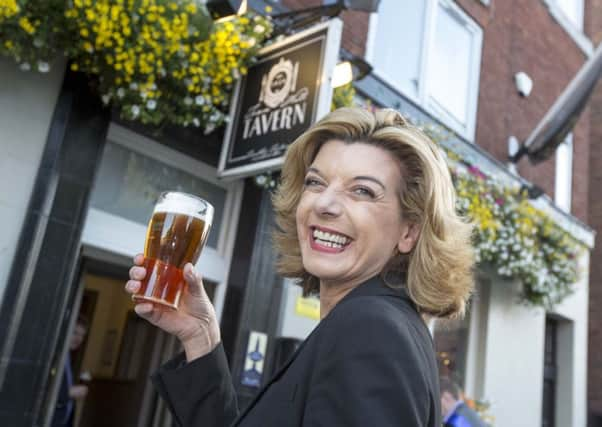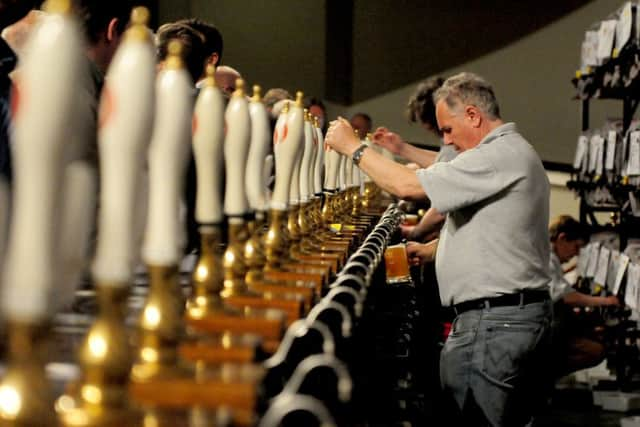The woman who tastes beer for a living - Annabel Smith, the beer sommelier


It sounds like one of those plum jobs people sometimes fantasise about, like being a video games tester or someone who gets paid to sleep, but there’s more to being a beer sommelier than meets the eye.
Annabel Smith, from Horbury, has spent her entire life working in the pub industry, starting off pulling pints behind the bar a her local, the Brewer’s Pride in Ossett, in 1990 - it was a ‘stop gap’ job while still at university. But it was while she was there, she caught the beer bug and found her calling in life.
Advertisement
Hide AdAdvertisement
Hide Ad“I loved the interaction with people,” she explains. “After a couple of years doing it, I became the manager and I stayed there for seven years before going to work for Whitbread.”


That job took her to Harrogate, Doncaster and Glasgow, after which she went to work for Di Agio in another job some might fantasise about: training people how to pour the perfect pint of Guinness.
After that, she took up a position at Cask Marque, tasting beers and training bar managers.
You might say Annabel eats, sleeps and drinks beer. She can certainly tell you a thing or two about the industry and its history.
Advertisement
Hide AdAdvertisement
Hide Ad“Guinness is a good example,” she enthuses. “A lot of people associate it with a shamrock in the foam but Guinness doesn’t endorse that at all and it’s a cultural thing. It began in the 1930s in Dublin when there were a lot of Americans coming to the area and one of the way they ended up being marked out was with a shamrock on top of their beer. A lot of people think Guinness was invented in Ireland, too, but it was actually first made in London.”


Or how about the origins of IPA: “That started in the 18th Century in England, as a lot of men went out to India as part of the textile trade but because they were often hanging around for months on end, many ended up getting smashed on the local drink, made from fermented palm rice, which was lethal. Only a third of them were coming back alive, which led to the creation of a beer which would be strong enough to survive the six month journey out there and still be safe and they added hops to it partly as an anti-bacterial agent. It was one of the first golden beers, no beer had ever tasted like it before.”
She goes on: “Traditionally, every village had a brewster and it was women’s work, she was known as an ale-wife. One of her jobs was whenever someone was getting married, she would make a particularly strong batch beer and it was known as the ‘bride ale’, which is where we get the word bridal from.”
Her knowledge of her field is matched only by her passion, which was put to the test during her training to become a sommelier.
Advertisement
Hide AdAdvertisement
Hide AdShe had to undergo a number of training modules from the Beer Academy and then blind taste 20 beers and be able to speak about their ingredients, flavours and faults. She qualified just before the real ale revolution, which she saw coming.


“I saw the change coming where beer was changing, partly because off the job I was in at the time. I was a beer taster and training manager for Cask Marque. It was becoming less of a ‘poor man’s drink’. I was seeing more and more of the cask and real ales coming through. I saw a lot more US beers coming over here. The market was changing and beer was no longer just that warm, flat bitter drunk by old men.
“When I got the chance to become a beer sommelier, I jumped at the chance. People are familiar with wine sommeliers and our job is similar. They tend to work in the catering industry and use their knowledge to pair wines with foods. While we can do that with beers, our main role is to educate people and change their attitudes.”
After working for Cask Marque, she decided to take the leap and strike out on her own.
Advertisement
Hide AdAdvertisement
Hide AdSince then, she’s never been busier, with events booked at Bishop Aukland, the Blacksheep Brewery and John Lewis in the Bluewater shopping centre, Kent.


“The thing I was most worried about setting up on my own was not getting any work. But I’ve not stopped working. It’s a growing market and companies are keen to invest in training their staff, because part of the resurgence comes from having an understanding of beer and how it goes together with food.”
Now she also trains other beer sommeliers, of which there are now about 100 in the country.
“If there’s a change, it’s not going to be a new beer but rather a cultural shift in terms of service and how our beer is served. You might argue that beer doesn’t have to come in pints, that it doesn’t have to come in an ugly glass. If you serve it in a nice glass, it’s much more appealing.
Advertisement
Hide AdAdvertisement
Hide Ad“There will always be lager but I think we’re edging away from the lager culture to the point where most people are willing to try something new.
“I still think more could be done to educate people, certainly, in terms of helping the consumer make a decision. That’s highlighted when you go into supermarkets and see the real ale section, which is sometimes just overwhelming. That’s where ’shelf talkers’ are useful - indicating to the customer that if they like something else, like gin or a certain type of food, then they might like to pair it with a particular beer.
“The fact I’m a woman doing this doesn’t really come up as an issue in the industry, where you’re judged on your knowledge and hard work, it’s more from outside. So, I’ll be chatting to a cabby and I’ll tell him what I do and he’ll say, ‘But you’re a woman.’ But it’s all positive curiosity.”
FACTFILE
Beer is thought to date back over 10,000 years - one story has it a woman was baking bread but left the mix out in the rain, which created a weak beer, after which the process was quickly investigated and refined
Advertisement
Hide AdAdvertisement
Hide AdHow you serve your beer can affect your experience - glasses with thick bases prevent heat transferring from your hands, while a wide opening allows the aromas to be released more readily
The hops in beer have known health qualities - they are antimicrobial and can help relieve stress and beer has been said to help reduce the formation of kidney stones. Beer is also thought to aid bone health. Indeed, ancient text from Egypt list over 100 medicinal uses
In the Middle Ages, children were encouraged to drink beer for its health benefits
Beer is made from germinated malt and grains, which, if brewed for longer and then distilled, would turn into whisky
Hops were originally added to beer to make it last longer but people grew to like the taste